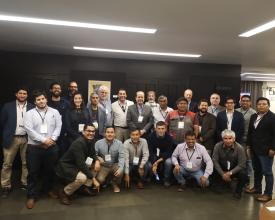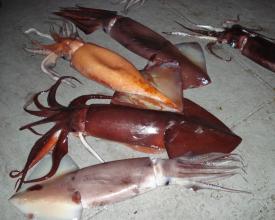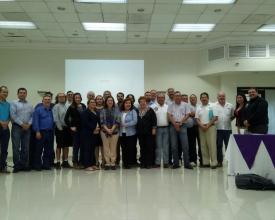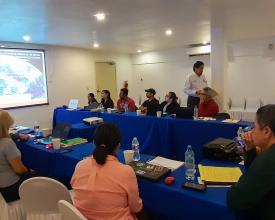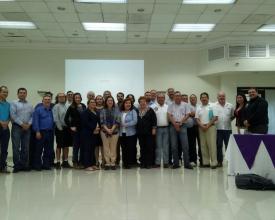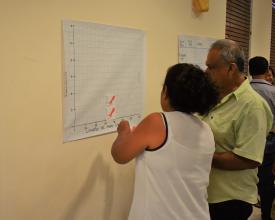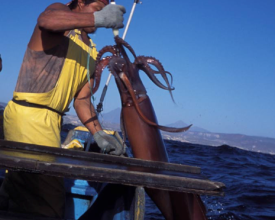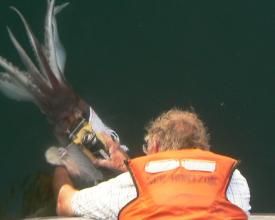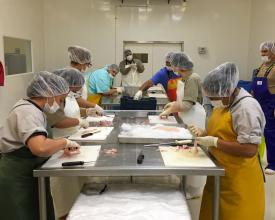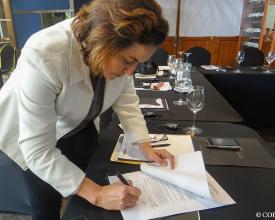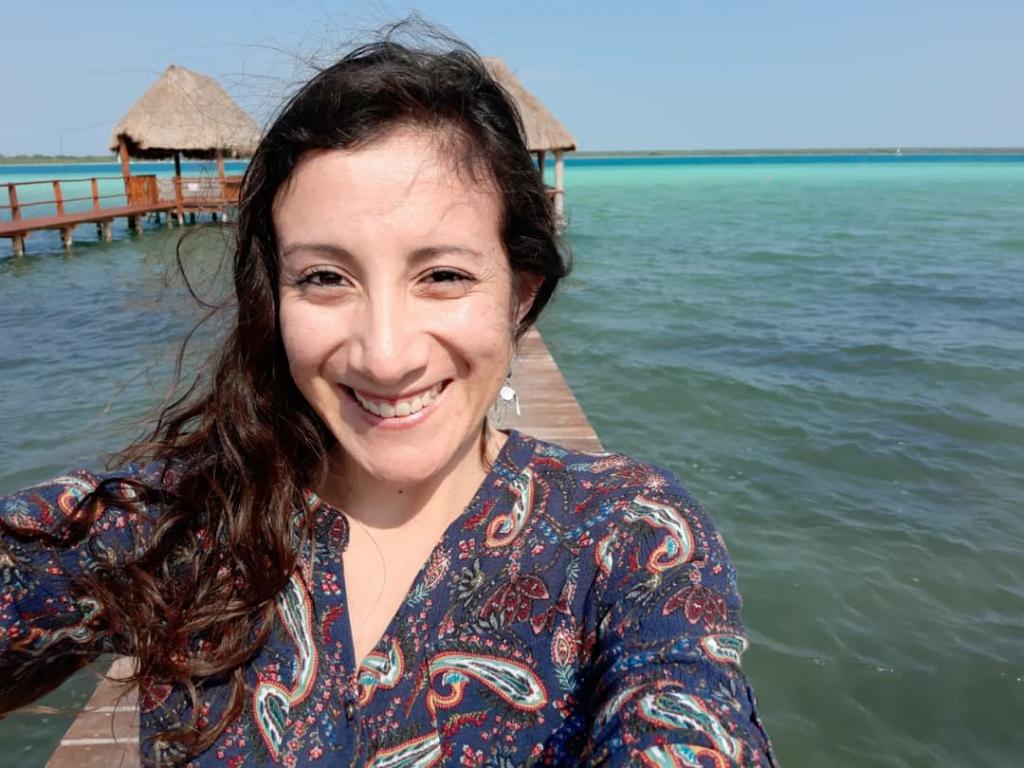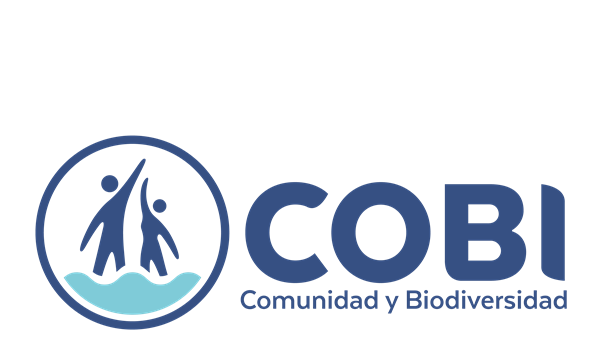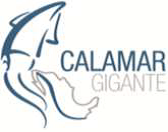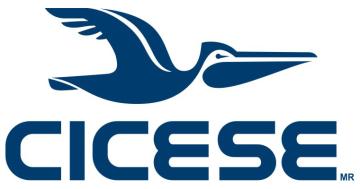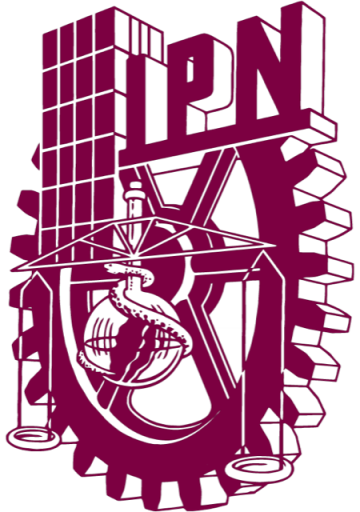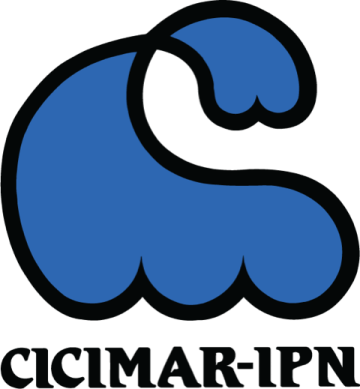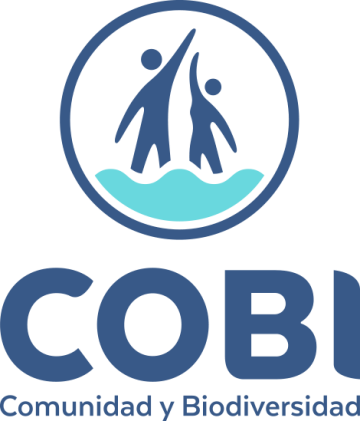
Giant squid fishery sustainability
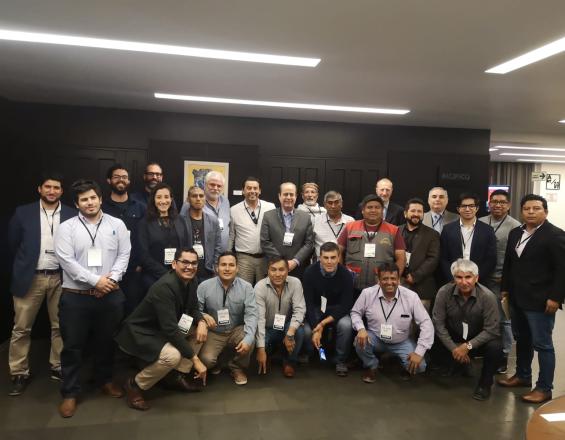
The giant squid fishery in Mexico has undergone considerable variations in its catches in the last decade, due to the low availability associated with its abundance, as it is mainly conditioned by the effects of climate change and El Niño (less abundance of the resource) and La Niña (the stock tends to recover). Given the fluctuations, the productive sector has had to adapt through different components to continue using the resource in a sustainable manner. Fishermen and fisherwomen have organized themselves into a National Product System Committee, a figure recognized by the LGPAS, which has made it possible to work on strategies at both the artisanal and industrial levels, through a monitoring system, synergies and multisectoral financing from the government and academia, as well as the integration of the value chain within their state committees.
Context
Challenges addressed
1. The squid fishery has faced climate change and environmental variations caused by the El Niño and La Niña climatic phenomena, representing an environmental challenge to sustain the fishery due to the strong effect they have on the availability of the resource.
2. An economic challenge is to have the financial self-solvency and good administration to implement the best sustainable fishing practices.
3. A social and governance challenge is to align the vision of the different actors involved with the sustainability of the resource.
Location
Process
Summary of the process
Fisheries are complex systems that involve ecological, social, environmental and management aspects to achieve sustainability. The actors involved in fisheries face challenges associated with each of these aspects, which are similar among fisheries, as reported by CEA Consultants in their review of fisheries improvement projects (at the international level) and PRONATURA (in Mexico).
The components of this solution work together to address: (a) the lack of updated information, implementing a fisheries monitoring system at the artisanal and industrial level and analyzing the impact of the fishery on the ecosystem; (b) deficiencies in the management system through multi-sectoral alliances and an effective governance system; (c) the lack of planning and vision in the short and long term for the financial sustainability of fishery improvement projects, through co-investment of the different actors involved in the supply chain; and (d) gender equality, identifying the contribution of women in the value chain.
Building Blocks
Co-management in the giant squid fishery
The actors involved in fisheries need to work under a management system that seeks to comply with national laws and regulations to consolidate the responsible and sustainable use of resources. It has been documented that organized groups achieve greater benefits if they are formed in a participatory manner with a common vision, work plans, agreed-upon rules, and commitment from government agencies.
The giant squid fishery integrates small and large-scale fishermen and fisherwomen, as well as all links in the value chain through the Comité Nacional Sistema Producto (National Product System Committee). The Committee identified the need to actively participate in fishery management and decision-making. This helped to form and formalize a technical-biological research sub-committee, made up of various sectors: government, academia, civil society organizations, and representatives of the national committee. This sub-committee established a common objective and internal regulations that set out the guidelines for assigning responsibilities and roles to each actor involved. This, in turn, strengthened governance and the collective effort to generate and document traditional and scientific information for squid co-management.
Enabling factors
- A high degree of organization among fishermen and fisherwomen, research and management institutions, since squid is an internationally shared resource, widely distributed and mobile.
- The existence of a multi-sectoral group that incorporates the knowledge of each sector, with the objective of generating research and information towards an adequate management of the fishery.
- Effective and transparent governance within the group (e.g., formalization, establishment of guidelines, responsibilities, procedures).
Lesson learned
- Carry out a mapping of stakeholders interested in the use and management of the squid resource.
- Generate a work plan with actions, roles and responsibilities.
- Generate signed agreements and follow-up by the stakeholders involved (fishing communities, government sector, academia, civil society organizations) that will allow progress in the improvements proposed in the work plan.
- Consider that the General Law of Sustainable Fisheries and Aquacultures (LGPAS) recognizes and encourages the commitment of government agencies with the product system committees (e.g., in follow-up, financing), being remarkable a better integration of the committees to the effective co-management of the fishery.
- Review in periodic meetings the agreements, advances and new challenges encountered in the management of the fishery.
- Identify the deficiencies of the fishery in contrast to international sustainability criteria (in the pre-assessment of the MSC standard).
- Share information with the different stakeholders in the fishery, through the fishery progress platform (https://fisheryprogress.org/).
Giant squid fishery monitoring
Having information for sustainable fisheries management is fundamental. Unlike many fisheries in Mexico, the giant squid fishery in small and large scale has implemented fishery monitoring since 2010. The National Giant Squid Product System Committee, together with the authorities (CONAPESCA, INAPESCA and SADER), designed and implemented the Integrated Fisheries and Environmental Information System for the analysis of the giant squid fishery (SIIPACAL) in Northwest Mexico. The platform collects detailed real-time information on catches (e.g., fishing zones, catch volumes, fishing effort, etc.), and environmental information (e.g., temperature, dissolved oxygen, salinity, etc.), to learn more about the behavior of the resource according to the fishing season and environmental conditions.
The data collected in fishery monitoring are fundamental to provide information on the state of the resource and to improve management, taking into account scientific information and traditional knowledge. These good practices can be adapted to any fishery and scale, as has been done by the Comité Nacional Sistema Producto de Calamar Giant Squid.
Enabling factors
1. Facilitate rapprochement with government agencies by the productive sector, and promote commitment to long-term collaboration.
2. Integrate the productive sector in the implementation of fisheries monitoring, provide training on the benefits of improving resource management, as well as methods for data collection.
3. Follow up on the analysis of data and its integration into decision making about the fishery by all stakeholders involved.
Lesson learned
- Knowing the information gaps in the fishery helps to develop a methodology to improve decision making in resource management.
- Designing and implementing an integrated monitoring system (SIIPACAL) in collaboration with the productive sector helps establish relationships of trust to contribute to good management.
- Train the productive sector in data collection (biological and fisheries) and have them validated by government agencies.
- To improve management and governance in the squid fishery, it is necessary for the productive sector to maintain active fishery monitoring through continuous follow-up and involvement of the productive and government sectors.
- The information generated should be shared with fishing communities, the government sector and academia, through previously agreed means, using available platforms.
- Define strategies for fishery management with the information generated.
Co-investment for sustainable fisheries
To achieve success in the sustainability of fishery resources, there must be active participation of diverse stakeholders (fishing communities, government sector, academia, civil society organizations and the market). In 2018, COBI began monitoring the costs (economic and in-kind) associated with the implementation and development of fishery improvement projects. From this exercise, it was documented that generally at the beginning of the projects, philanthropy makes the largest economic investment through CSOs, while fishing communities make it in-kind (e.g. making their boats available for activities), and other actors also participate (e.g. government bodies or academia). The objective of community co-investment is to ensure that, over time, the fishing communities become organized and committed to continue paying the costs associated with this type of project, and to achieve greater financial autonomy. COBI and the fishing communities jointly developed a written strategy with a five-year term, in which the communities commit to maintain a gradual percentage of economic contributions to achieve co-responsibility and manage the project on their own.
Enabling factors
1. Stakeholders are aware of the project's costs and have a gradual financial strategy for co-investment.
2. Stakeholders have transparent and accountable processes in place to build trust, and thus sustain fishery improvement projects in the long term.
Lesson learned
- Mapping the stakeholders in the co-management of the fishery from the beginning. This makes it possible to make visible all those who can/should participate in the financial contributions of improvement practices and project monitoring.
- Integrating and training all actors involved in the value chain on the importance and benefits of being co-investors in fishery improvements.
- Consider financial and in-kind contributions (e.g. human capital, time invested, data/information generation, infrastructure-meeting space). This allows valuing, recognizing, and making visible the contributions and commitment to sustainable fisheries from each sector.
- Achieving co-investment is not a simple process, as it involves financial issues. For this reason, it is necessary to train participants and make them recognize its importance.
Modeling the ecosystem with little data
By their nature, small-scale fisheries tend to have limited, poorly systematized data and short time scales. This scarcity of information represents a challenge for understanding, for example, the interaction of fishing gear with the ecosystem and its impact on the habitat; such information is fundamental in the implementation of a fishery improvement project. Around the world, different methodologies have been developed to generate information on the impacts of the fishery on the ecosystem; one of them is the modeling based on the Ecopath program with Ecosim.
COBI used this tool including information generated by fishermen and fisherwomen through fishing logs, as well as biological and ecological information for the species that inhabit the fishing zones. In addition, to strengthen the model, the traditional ecological knowledge of the fishing communities was integrated through the application of interviews, from which relevant information was obtained on the diet of the species, their geographic distribution, reproductive season, etc.
Enabling factors
- The fact that fishermen and fisherwomen are generating information on fisheries through fisheries monitoring.
- It is important to integrate the traditional knowledge of fishermen and fisherwomen, since they have a large amount of important information about their natural environment and species.
- The results must be shared with the people of the fishing community, so that they value and appropriate their knowledge.
Lesson learned
- The process to obtain the results from Ecopath modeling with Ecosim can take about six months, since it is necessary to search for information, interview people in the community, analyze the information and create the models.
- It is important to socialize with the fishermen the importance and benefits of knowing the effects of the fishery on the ecosystem, and to let them know how their traditional knowledge is integrated in order to obtain more robust information for ecosystem management.
- The interviews conducted with the fishermen to record their traditional knowledge were long (approximately 40 minutes), which sometimes caused the interviewee to lose interest. In addition, with respect to the time needed to conduct each of the interviews, the availability to interview more members could be scarce.
Visibility of women's participation in decision-making in fisheries
In 2017, COBI initiated a fishery improvement project in collaboration with the National Committee Giant Squid Product System, which has sought to document and support both efforts and commitments to sustainable fisheries, as well as support the role of women as leaders in decision-making within the National Committee. This has been possible thanks to two main factors: the visibility and integration of women in positions of power, such as occupying presidency roles within the committees, and the openness to involve women in a significant way in the planning, implementation and management of work plans to improve the fishery.
This openness allows setting an example of a better adaptation to egalitarian social dynamics, thus recognizing the productive sector as an extensive and complex system to ensure the sustainable management of marine-coastal resources.
Enabling factors
- Conducting workshops to reflect on the current situation and future projections in terms of gender equality.
- Empowering women by including them in positions of power and decision-making processes.
- The organizational structure of the committee should be seen with an egalitarian and well-represented approach.
- The productive sector should be viewed from an approach based on the fishery as a whole, and not only on extraction.
Lesson learned
- Mixed teams (men and women) and the diversity of people participating in the different stages of the value chain promote better performance because they have a robust and complementary view of opinions, perspectives, knowledge and experiences.
- It is key to involve women in decision making to improve co-management of resources, as the knowledge and experience from their perspective drives the achievement of objectives in a holistic manner within the fisheries; and the diversity of voices balances governance.
- It is important that women themselves demand their space and demonstrate the benefits that the sector can obtain in the good management of fisheries.
- The work carried out by men and women are often complementary activities. This avoids a confrontational situation.
- By emphasizing how gender equality contributes to fishery improvement projects and to the sustainability of fisheries, fishing communities are more likely to adopt a gender perspective in their projects.
Impacts
1. International recognition as a good option for consumption in the Monterey Bay Aquarium's Seafood Watch.
2. Collaboration between the productive sector and the government sector for the management of the fishery.
3. The generation of information for the adequate management of the fishery, through a system of fishing and environmental monitoring in the artisanal and industrial fleet.
4. Collaboration with academia for the study of giant squid biology and its relationship with the environment.
5. Participation with the sector's experience on the good management and governance of the fishery in the CALAMASUR group, for the management of the fishery at the Latin American level.
6. Strengthening producers and key actors to maintain the governance of the state committees.
In four years, the giant squid fishery has improved its score in 24 of the 28 indicators of the standard established by the Marine Stewardship Council (MSC), achieving a grade of A, due to its good management and better information available.
The fishery operates in such a way that the resource is not overexploited, while maintaining the structure and function of the ecosystem on which the fishery depends.
Beneficiaries
Artisanal and industrial fisherwomen and fishermen, and the value chain of the giant calmar fishery. Approximately 8,048 people in four Mexican states.
Sustainable Development Goals
Story
The productive sector that catches giant squid considers this to be a young fishery. However, since the 1980s, fishermen and fisherwomen have carried out selective fishing (with a line as fishing gear), with zero bycatch and very low impact on the ecosystem. Due to the characteristics of the fishery, its good practices have always been aligned with the most rigorous international fishing sustainability criteria. Since 2010, the presence of the species in Mexico has decreased due to climate change, and the sector has taken advantage of this to document its practices, prepare robust organizational foundations, and thus prevent mismanagement of the resource. Currently, they have a monitoring program that is exemplary for other fisheries, and a technical-biological research sub-committee, which promotes the work of multiple actors, which has given them international recognition.

